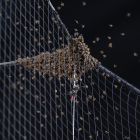The Los Angeles Dodgers made two notable free-agent signings during the offseason: outfielder A.J. Pollock and reliever Joe Kelly. Both have struggled through the season's first 15 games. Pollock has failed to capitalize on a big opening series, and entered Saturday with a 78 OPS+. Kelly, meanwhile, has fared even worse.
Kelly has pitched in six games and has given up at least one run in five of them. His sole clean sheet came in a game in which he faced one batter. All together, he's permitted 10 runs on 15 hits in 7 1/3 innings. He came into his Friday night appearance with the majors' lowest fastball whiff rate -- that despite averaging 97 mph on his heater (a tick down from last year, to be fair).
There's no use overreacting to small samples -- particularly for relief pitchers. But Kelly's early-season woes are interesting because they appear to be a case where an intelligent front office is receiving immediate, undeniable feedback that they've messed up. Where the Dodgers have erred isn't in signing Kelly -- who excels in velocity, spin rate, and all those other things mothers warn children about -- but in their implementation of him. The Dodgers are not using Kelly the way he's typically been used, and have seemingly asked him to change his approach.
Kelly's stock gained helium last October when he made three multi-inning relief appearances during the postseason. Clearly the Dodgers were taking notes, because they're trying their hardest to make him into a multi-inning reliever. Kelly has recorded at least four outs in four of his six appearances, second-most in the National League behind D.J. Johnson of the Colorado Rockies. For reference, Kelly made six multi-inning appearances all last regular season. He did make 15 such appearances in 2017 -- a season in which he posted his best ERA despite shaky peripherals -- but had just 22 outside for his career outside of that season entering the year.
The Dodgers have done more than ask Kelly to alter his role; they've transformed his arsenal.
Kelly is no stranger to modification. Year after year he seems to try something different. In the past, Kelly has tinkered with which of his breaking balls to use as his main secondary pitch. This season, Kelly has thus far embraced his changeup over both, throwing it 25 percent of the time, per Statcast. His current-high changeup usage rate is 12.6 percent. One can only presume the Dodgers noticed Kelly's cambio had the highest swinging-strike rate of any of his pitches last season, and decided he should throw the pitch more to improve his effectiveness.
That isn't the only philosophical tweak Kelly has exhibited thus far, however. Whether by design or substandard command, he's throwing his fastball lower than he has in the past. According to Brooks Baseball, Kelly's average vertical location is slightly below the middle of the strike zone. His heater had averaged a height of at least 0.33 inches above the middle of the zone in each of the past three seasons, making this a noteworthy shift if it is indeed intentional.
What's important is that some of these changes have to be intentional -- the Dodgers certainly know how they're using Kelly, and Kelly has to know how he's shied away from his breaking balls. The question, then, is how much longer will they continue to try these new approaches if they continue to breed poor results? The Dodgers are the odds-on favorite to win the NL West, but that doesn't mean they can continue to trot out Kelly in suboptimal ways and withstand the damage that comes from shaky outings -- either to their record or his psyche. At some point, they'll have to flip the switch, even if it means him reverting to his old ways.
There's no telling because, for now, it appears the Dodgers are willing to experiment with Kelly regardless of the results.






















